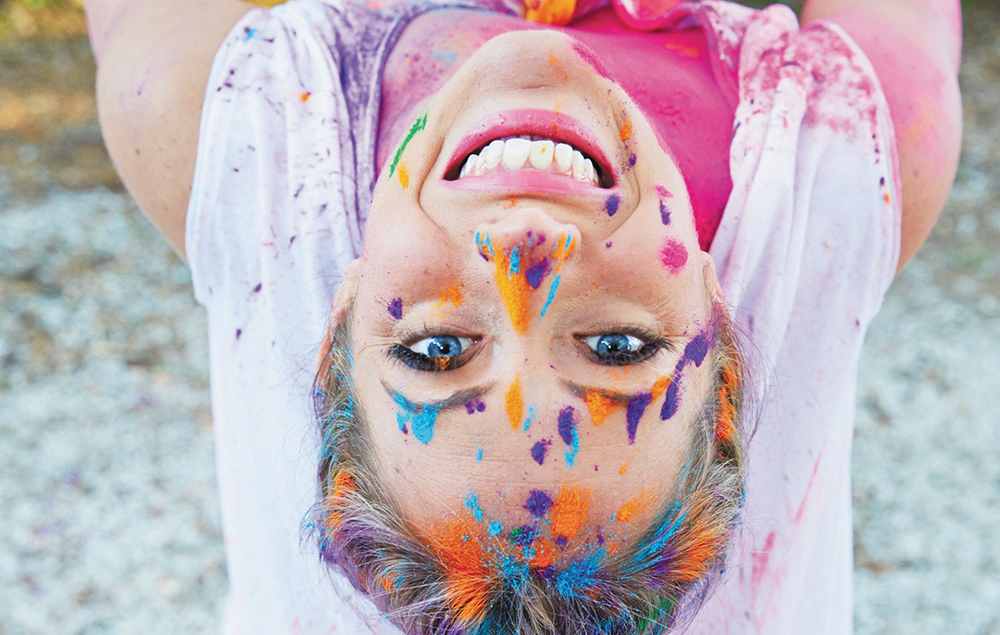Going big in the yoga industry while staying true.
Do a quick Google search for Kathryn Budig and you might think you’ve stumbled upon rock star.
She’s gorgeous, fit, chic, glows with confidence — and she’ll joyfully lead you in your next vinyasa class. At 33 years old, the internationally renowned yoga instructor’s expertise is backed by more than a decade of experience including writings in Yoga Journal and Women’s Health.
In an avant-garde approach, her poses have occupied billboards for Under Armour’s ‘I Will What I Want’ campaign, and challenged contemporary stereotypes of yoga through Jasper Johal’s nude captures of her for Toe Sox ads.
Inarguably, Budig has created a successful career that blends yoga, travel, health and community — a combo that’s challenging on the individual level, let alone in a still-burgeoning industry: 36.7 million people practice yoga in the U.S., up from 20.4 in 2012, according to the 2016 Yoga in American Study.
Though, even amidst the spotlight, scroll through Budig’s Instagram and you see a woman that pokes fun at her acne, exhaustion and dogs. SGB caught up with this down-to-earth, Kansas-native on the heels of her recently released (and second) book, Aim True, and talked about how she’s taken her talents from the yoga room to the masses. In true form.
Tell us about the premise of Aim True. Aim True breaks down a life philosophy that came to me in 2010. Inspired by the Greek goddess Artemis, I read a line in a prayer that said, “aim true,” during a time when I needed help and support. The idea changed my life, and I realized it could help people on a universal level. Now, I’ve been teaching the philosophy for years. It was only a matter of time before I put it down on paper. The book shares how this philosophy is applicable to life, and daily exercises that apply to how you view your physical body and your food, how you cook your food, how you interact in your friendships and relationships, and how yoga is a tool for tuning your mind and for mediation.
When did the idea for ‘aiming true’ come to you? I was living in L.A. and going through a phase in my life when I really wanted to be loved and in a relationship. I was tired and not having any success at all. With this idea I realized that I don’t need another person to complete me. It was a gentle reminder that I can’t look to other circumstances and people for happiness: it comes from my own self worth, which gave me a platform and inspiration that I could offer to other people and my students.
As an international teacher, how do you strike a balance with healthy eating and living life on the road? It’s important to know what makes us feel good and to stay open for experiences. I feel good if I cut out dairy, gluten and grain. I cook that when I’m home. On the road, I’m open to experiencing the culture and cuisine, which inspires me as a cook. I’m not horribly strict: it’s about balance. I won’t have a huge bowl of noodles, but that doesn’t mean I’m not going to try it.
What are your top three pieces of advice for achieving a holistic approach to yoga, diet and mindfulness?
• Know your body. We are all wired so individually. You have to figure out what makes you feel good. Don’t let others’ opinions or rules influence you.
• Enjoy being a beginner. There’s no use in rushing anything. If you don’t understand something, it doesn’t mean that you’re lost. It means you have a reason to show up to learn more.
• Nothing is set in stone. It’s never too late to reinvent yourself. That goes for any aspect of your life: work, relationships and circumstances. If you are not feeling alive, I truly recommend making that change. Never tell yourself that you’re stuck.
How have you differentiated yourself in a saturated, growing market? I never feel the need to stick to a blueprint. I try to listen to what I get fired up about, what excites me, and to follow that path. People may tell me that an idea is not going to work, but I stick to my guns on what I think is going to be successful and what impassions me. If I am not fired up about it, then it will not affect other people. I stay honest with who I am, my voice and what I want to put out into the world. I try to be me, unabashedly.
The ToeSox ad campaign stirred some controversy: What’s your overall opinion regarding marketing in the yoga industry? Before I sign up to do anything — like a contract to work with a company or a social media post — I make sure that I believe in it 100-percent. That doesn’t mean that everyone else will believe in it 100-percent. I will never do something because it’s a good paycheck. Anything that I do backs up my belief system. As long as it is, I’ve become proficient at drowning out expectations of others.
The stress that goes along with running a huge business could easily counteract the philosophy that your life and work embodies. How do you overcome those challenges? A lot of people in the yoga world have the sentiment that working at a high level is not good, and that yogis should be happy working on a small scale. I don’t believe in that. I believe that we all deserve to have reach, and if you’re gifted you should share your talent. If you are pursing something you fully believe in then there should be no shame. Of course, I would not do an advertisement for McDonald’s for a million dollars — I have to believe in their manifesto.
Lead photo courtesy Kathryn Budig











